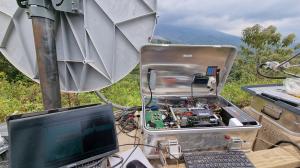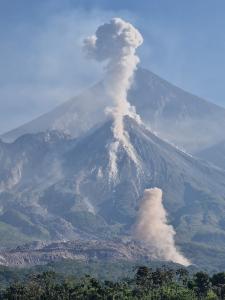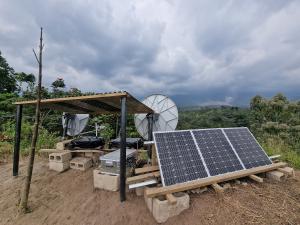Early warning system for dangerous volcanos with ADC card by Spectrum
Spectrum’s PCIe digitizer card detects smallest movements over a distance of six kilometers
I’ve used Spectrum cards in other projects, so I know their high standards of manufacture. I can be confident that it will keep on working deep in the jungle so I won’t have to fly there to replace it”
GROSSHANSDORF, GERMANY, May 11, 2023/EINPresswire.com/ -- Guatemala in Central America has three constantly active volcanos, all of which have villages near them so it is vitally important to have an early warning system for eruptions to save lives. Such systems already exist but these specific volcanos produce flows of Pyroclastic Density Current (PDC) instead of lava. The extremely dangerous PDC clouds consist of gas, rock and ash, traveling at speeds of up to 600 km/h with a heat of up to 800°C. It is therefore vital to have as much warning as possible for evacuations. A team from University College London (UCL), led by Dr Amin Amiri, is studying the PDCs and developing a radar-based early warning system with a very high level of sensitivity. The core part is a PCIe digitizer card by Spectrum Instrumentation, the model M2p.5921-x4. It is so sensitive that it can detect tiny movements at a distance of six kilometers, which is the distance that the equipment is set up from the slope of the volcano.— Dr Amin Amiri
The equipment consists of a X/Ku-band radar system including reflector dishes for transmit and receive. The returning signal is compared to the outgoing signal to produce an Intermediate Frequency (IF) signal containing range and movement information whenever a PDC shows up on the slope of the volcano. The IF signal is digitized by the M2p.5921-x4 Spectrum card with 20 MegaSamples per second and processed using Spectrum’s SBench 6 measurement software.
“We have just returned from setting up the equipment that is monitoring one of the slopes of the Santiaguito Volcano,” explained Dr Amin Amiri. “This is the first research into PDC events to try and understand the mechanisms for this type of volcanic activity. As you never know when it is about to happen, we have a seismic activity detector that turns on the radar system when it detects a tremor. This ensures we only capture relevant data on a PDC event. In this way we also conserve the battery power of the system which is deep in the Guatemalan jungle and charged by solar panels. We will be back in a couple of months to collect the stored data, and to install two more setups that will monitor the other two slopes.”
The original design was specified to work at a distance of four kilometers from the target, but the terrain in the jungle was not suitable so it was set up further back on a high spot of land six kilometers away. The team was concerned that the equipment would not be sensitive enough for this 50% increase in distance and used a drone flying over the jungle treetops to the slope as a moving target to verify that it was working properly.
“Sensitivity is the key to the success of this system as an early warning,” added Dr Amiri. “We tested the Spectrum card and found that it has an incredibly impressive low noise floor of -100 dBm so we could build a Moving Target Indicator (MTI) system that can see all small movements of the volcano that are the first signs of a PDC.”
The biggest challenges encountered by the team were the heat, the humidity and the mosquitos. Not only did they have to protect themselves from them but also all the electronics. A metal box is used to keep out the humidity, the rain and the wildlife but then cooling is a challenge as holes in the box are not possible and the temperature in the jungle exceeds 35C. Keeping the box in the shade and having a fan inside the box to keep the air circulating were a help. The team is now working on improvements for the next systems, such as large fins on top of the box to radiate heat away or a small solar-powered fridge. “One factor in selecting a card from Spectrum was that it’s specified to work over a large temperature and humidity range. Plus, it has thermal cut-out for protection if the environment becomes too hot,” concluded Dr Amiri. “I’ve used Spectrum cards in other projects, so I know their high standards of manufacture. I can be confident that it will keep on working deep in the jungle so I won’t have to fly half around the world to replace it!”
About Spectrum Instrumentation
Spectrum Instrumentation, founded in 1989, uses a unique modular concept to design and produce a wide range of more than 200 digitizers and generator products as PC-cards (PCIe and PXIe) and stand-alone Ethernet units (LXI). In 30 years, Spectrum has gained customers all around the world, including many A-brand industry-leaders and practically all prestigious universities. The company is headquartered near Hamburg, Germany, known for its 5-year warranty and outstanding support that comes directly from the design engineers. More information about Spectrum can be found at www.spectrum-instrumentation.com
Sven Harnisch
Spectrum Instrumentation
49 4102 69560
email us here
Visit us on social media:
LinkedIn
Legal Disclaimer:
EIN Presswire provides this news content "as is" without warranty of any kind. We do not accept any responsibility or liability for the accuracy, content, images, videos, licenses, completeness, legality, or reliability of the information contained in this article. If you have any complaints or copyright issues related to this article, kindly contact the author above.



